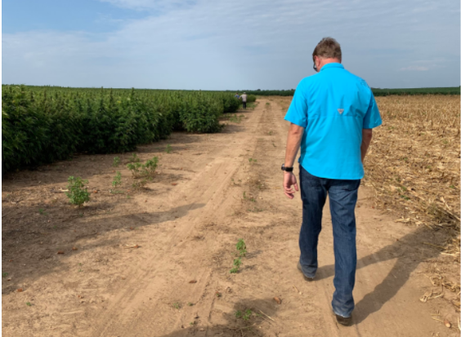
Generation Hemp’s Green Policy is Inspired by a Cause, Executives Move From Oil and Gas to Industrial Green
Previously Published to Benzinga: The following post was written and/or published as a collaboration between Benzinga’s in-house sponsored content team and a financial partner of Benzinga.
Generation Hemp, Inc. (OTCQB: GENH) is creating its own “Industrial Evolution,” leading an industry by example and contributing to a greener tomorrow. Ironically as it may seem, the company’s lead principals were once major players in the oil and gas industry — a notoriously sharp contrast to anything the world sees as “green.”
To them, the frontier in “all things cannabis” is more than just a trend. They want to give back to the environment and cut back on the carbon footprint — a modus operandi that may have not seemed a focal point of their former industries. Applying new hemp-inspired mindfulness, the company takes strides toward contributing to a greener world and a greener place for future generations.
Benzinga sat down with Melissa Pagen, senior vice president of corporate development for Generation Hemp, and discussed how the company’s green policy came to be.
Strengthening Business, Re-Assessing its “Greenness”
Although Generation Hemp has a hand in several sectors of the hemp industry, it’s primarily known for its role in drying, processing and storing hemp. The company serves U.S. farmers and growers — from the small towns across America to the skyscrapers of the corporate elite.
“The hemp space is nothing short of inspiring,” discusses Pagen. “Once your interest is piqued by the topic of hemp and becoming part of the hemp industry, your first step is research.”
“As you dig deeper into the plant — the history, the misconceptions, the characteristics of the plant and its uses as well as its products and how many people are beginning to discover its magic — you begin to see possibilities and an outlook for a much better future. You begin to see green.”
Hemp has over 25,000 uses — biofuels included — many of which have piqued the interests of Generation Hemp, raising the questions:
- Which industrial pain points can be addressed with hemp?
- How can the operations that get us there be eco-friendly?
“As we answered these questions, we realized that while the first operation that we acquired, a hemp processing facility, had the look and feel of an industrial operation, it could be moved towards heightened sustainability,” elaborates Pagen.
The team looked at every element of operations to see where, if any, green adjustments could be made.
And, There it Was — Stored in Plain Sight

After processing millions of pounds of hemp, the company was also left with millions of pounds of byproduct. This was only taking up valuable warehouse space, which was limited.
Despite having no initial need for this byproduct, the company didn’t want to charge its clients disposal or haul-away fees and the risk the cost-effectiveness of their service for farmers.
The team asked themselves, “How can we make this entire process more sustainable?” “How do we keep from discarding millions of pounds of this leftover material per year?” The answers they found garnered approval from their investors.
1 Critical Element led to a Greener Infrastructure
Generation Hemp set out to create a highly sustainable, zero-waste operation. Additional steps were then taken to prepare for the company’s future. Specialized, third-party engineers were hired to provide expert guidance and assessment.
Suffice to say, sustainability was not going to be cheap.
The company looked extensively into the animal bedding space, discovering studies that demonstrated hemp as the healthiest material for animal bedding of choice. In addition, consumer testimonials raved of its potential.
Generation Hemp also learned that most sellers were in frequent backorder. These companies imported materials, internationally, but couldn’t source enough material to sustain an ample supply of animal bedding product inventory.
This translated into a massive opportunity for Generation Hemp, who would now vet new markets and add equipment to its lineup. With the launch of not just 1 — but 2 — thriving animal bedding businesses, Generation Hemp is a step closer to its policy goals.
Very soon, farms and pet owners will have a reliable supply of hemp animal bedding. Both Rowdy Rooster and Kentucky Gold will debut later this fall.
On Sept. 2, Generation Hemp Chairman and CEO Gary C. Evans plans to speak at the Southern Hemp Expo 2021 in Raleigh, North Carolina, where, at 2:50 p.m., he will discuss financial wellness for companies in the hemp industry.
Evans Explains His Stance on the Company’s Green Policy
“When you are involved as a business owner in the hemp industry, you also become part of the hemp community,” states Evans. “This community was pioneered by a group of passionate people who have fought over the years for the legalization and utilization of hemp.”
Evans wholeheartedly believes that at the core of the hemp community’s principles is an environmental awareness that has the potential of immeasurable impact on the environment.
“As a former fossil fuels executive, I want to leave an impact that I can be proud of regarding our goal to fix the environment in which we live and breathe,” he continues. “It’s incumbent upon hemp companies to make every effort we can to align with these principles. We will continue our efforts to make our operations sustainable and implement green policies wherever possible.”
Other green brands that operate in the processing and distribution of cannabis include leaders such as Aurora Cannabis Inc (NASDAQ: ACB), Tilray (NASDAQ: TLRY) and Trulieve Cannabis Corp (OTCQX: TCNNF), whose focus is on medical and pharmaceutical grade marijuana, as opposed to nationally and federally legal industrialized hemp.
To find out more about Generation Hemp and its subsidiary brands, check out https://www.genhempinc.com. To learn the difference between cannabis and marijuana, check out this article Benzinga published in July.
The preceding post was written and/or published as a collaboration between Benzinga’s in-house sponsored content team and a financial partner of Benzinga. Although the piece is not and should not be construed as editorial content, the sponsored content team works to ensure that any and all information contained within is true and accurate to the best of their knowledge and research. This content is for informational purposes only and not intended to be investing advice.



